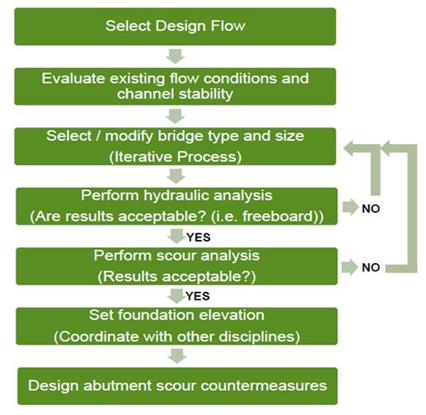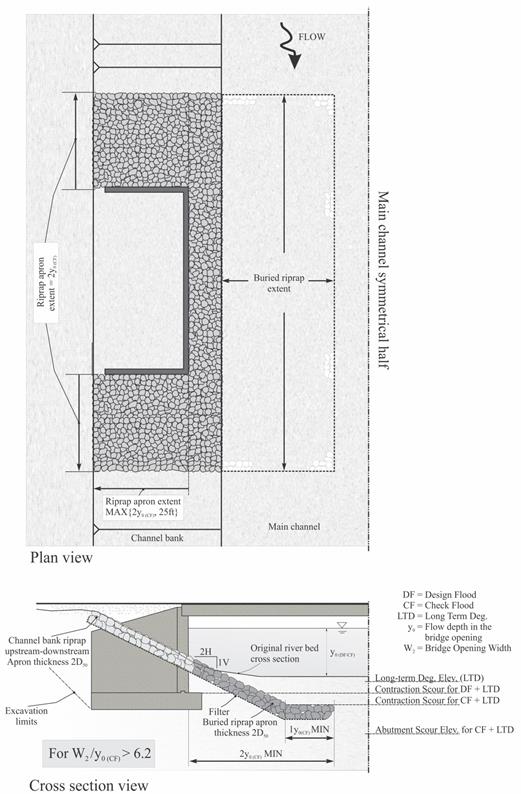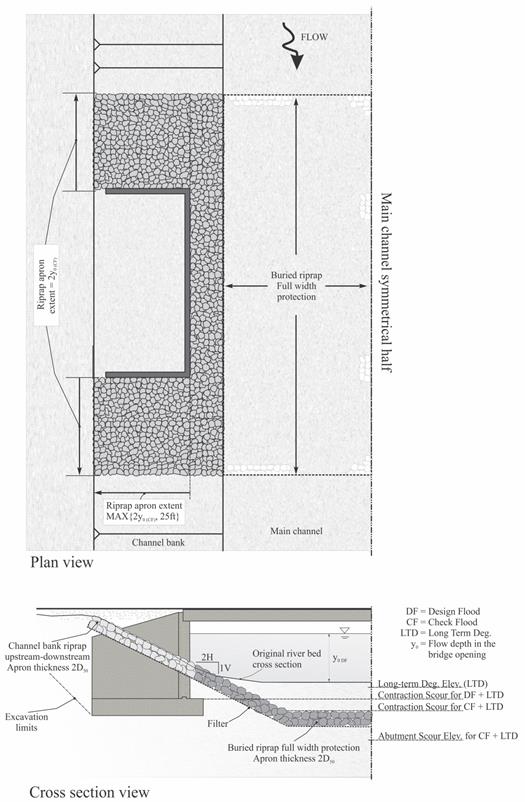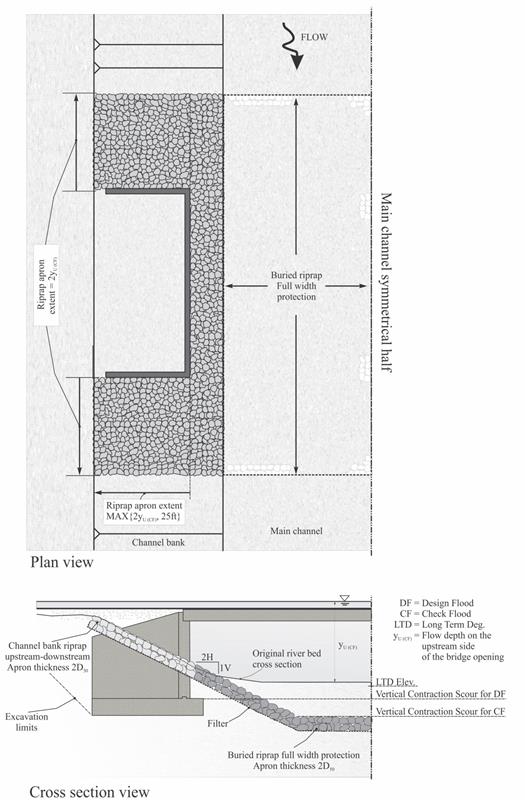U.S. Department of Transportation
Federal Highway Administration
1200 New Jersey Avenue, SE
Washington, DC 20590
202-366-4000
Federal Highway Administration Research and Technology
Coordinating, Developing, and Delivering Highway Transportation Innovations
| REPORT |
| This report is an archived publication and may contain dated technical, contact, and link information |
|
| Publication Number: FHWA-HRT-17-013 Date: February 2017 |
Publication Number: FHWA-HRT-17-013 Date: February 2017 |
Shallow foundations (e.g., spread footings) have been successfully used for bridge abutments at river and stream crossings. However, when a shallow abutment foundation is being considered for use in a river or stream environment, it is vitally important to fully understand the hydraulic design requirements. The guidance provided in this appendix identifies the major hydraulic requirements that, if followed, provide greater assurance that the shallow foundation will perform as intended. This guidance supersedes that currently provided in HEC-18, fifth edition, and HEC-23, third edition.(2,3)
The design of bridges in a river environment is a very complex endeavor because of the complex interactions among the structural components, the soils in which they are founded, and the moving water that imparts hydraulic loading to both. For this reason, an interdisciplinary team of structural, geotechnical, and hydraulic engineers should always be fully engaged in the bridge scoping, design, and construction processes. From a strictly hydraulics perspective, it is of utmost importance that a qualified hydraulics engineer, experienced in river mechanics, sediment transport, and bridge hydraulics be part of the interdisciplinary team.
When bridges are constructed over a waterway, their foundations must be designed, detailed, and constructed in compliance with section 2.6 (Hydrology and Hydraulics) of the American Association of State Highway and Transportation Officials Load Resistance Factor Design Bridge Design Specifications or an FHWA division office-approved drainage or bridge manual.(25) In addition, the bridge impact on the numerous floodplain values that may be present must be evaluated in accordance with the U.S. Code of Federal Regulations (23 CFR Part 650 SubpartA).(26) These compliances are required for the project to be eligible for Federal assistance.
The minimum hydraulic design considerations that should be evaluated when deciding whether a shallow abutment foundation is appropriate for a waterway bridge follow:
The listed descriptions of hydraulic design considerations reflect preferred conditions for shallow foundation abutments. The greater the departure from these preferred conditions, the more likely that alternative abutment types or drainage structure types (e.g., reinforced concrete box culverts or pipe culverts) should be considered. Under these circumstances, it is recommended that economic analyses be used to identify the preferred alternative.
The bridge hydraulic design process applicable to shallow foundation abutments is illustrated in figure 123.

Figure 123. Flowchart. Bridge hydraulic design process.
The steps in this multidisciplinary process are described as follows:
For shallow abutment foundation design, the following primary scour components must be computed and evaluated: (1) LTD, (2) contraction scour, and (3) abutment scour. Both the contraction scour and abutment scour components are sensitive to what sediment transport regime exists upstream of the bridge (i.e., live-bed versus clear-water) and whether the scour floods are under free-surface flow or pressure flow conditions (e.g., bridge girders are in the flow) at the bridge. Because of the dramatic increase in potential scour depth, pressure scour should be avoided, if at all possible. In addition, the abutment scour component is sensitive to the location of the abutment relative to the main channel. When the abutment is located close to the channel, the scour is computed differently than when it is some distance away (i.e. more than twice the main channel flow depth for the scour check flood).
The manner in which these individual scour components are evaluated for floods up to and including the scour check flood standard is summarized as follows by flow condition.
As indicated, the conditions and interaction of the scour components can be complicated and must be identified and analyzed by a qualified hydraulics engineer. Refer to HEC-18 for detailed definitions of the individual scour components and conditions that apply to abutment analysis and design, and for the various methods available to compute the scour magnitude for each component.(2)
The scour used to establish the spread footing foundation elevation is the worst-case combination of applicable scour components estimated for floods up to and including the appropriate scour flood standard (e.g., Q500 for scour check flood), and depends on the flow condition (i.e., whether free-surface or pressure flow exists at the bridge). The manner in which the individual scour components are combined for scour design is summarized below for each flow condition and illustrated in figure 124 through figure 127. The combinations listed are for abutments located close to the channel bank. Note that the underlining is a reminder to the user that measurements for scour check flood should be used and not those for scour design flood.
 1 ft = 0.305 m. |
| Figure 124. Drawing. Free-surface flow with no scour countermeasure (option 1). |
 1 ft = 0.305 m. |
| Figure 125. Drawing. Free-surface flow with narrow-opening scour countermeasure (option 2). |
 1 ft = 0.305 m. |
| Figure 126. Drawing. Free-surface flow with full-width scour countermeasure (option 3). |
 1 ft = 0.305 m. |
| Figure 127. Drawing. Pressure flow scour countermeasure. |
It is important to note that scour depths must be tied to an appropriate reference elevation. The channel thalweg elevation should be used as the reference elevation for abutments located near the main channel.
When a shallow abutment foundation requires installation of a scour countermeasure, the countermeasure must include a horizontal apron designed to be stable for the scour check flood. The apron should surround the entire abutment face and extend upstream and downstream of the abutment. For free-surface flow options 2 and 3, the extensions should be a distance equal to twice the main channel flow depth through the bridge, 2y0. For pressure flow, the extensions should be a distance equal to twice the main channel flow depth upstream of the bridge, 2yu. In addition, the same designed countermeasure should run up the channel bank and protect the abutment embankment. To do this effectively, the countermeasure should be configured to cover the embankment to an appropriate height (including freeboard) and for a distance of 2 times the main channel flow depth or 25 ft (7.6 m), whichever is greater, behind the abutment and parallel to the roadway.
Figure 124 through figure 127 illustrate the appropriate scour and countermeasure design configurations for the described flow conditions and options. Note that, although the countermeasure configurations are all similar, there are dimensional differences that make each case unique. Also note that the figures reflect the use of rock riprap as the countermeasure type. When riprap is used as the designed countermeasure, an appropriate filter must be placed under the riprap to prevent the underlying soils from being winnowed out through the interstitial openings between rocks.
There is one additional scour countermeasure design consideration for shallow foundations that support GRS and similar abutments. When the scour check flood overtops an approach roadway, a potential exists for the GRS abutment to be attacked from the back side. The likelihood depends on the depth of the overtopping flow, its duration, and the erosion resistance of the embankment. Research that defines the potential failure mechanism and most appropriate countermeasure configuration has yet to be conducted. However, the following additional countermeasure treatment is recommended when abutment embankment overtopping occurs for the worst-case scour condition:
There is also one hydraulic/structural design consideration for GRS type abutments. When a scour flood inundates an abutment, either by free-surface overtopping flow or pressure flow conditions, the top of the GRS mass is subject to unknown hydrodynamic forces that may scour GRS material from around the beam seat. Should either of these flow conditions be present, it is recommended that the GRS abutment be constructed wide enough to accommodate placement of the scour countermeasure on top of the GRS mass.
Designing countermeasures for shallow foundation abutments in a river environment can also be a very complicated endeavor because of the complex interaction between the hydraulics, the multiple scouring mechanisms that are typically present, and the structural components. For these reasons, it is again of utmost importance that a qualified hydraulics engineer, experienced in river mechanics, sediment transport, and bridge hydraulics, perform the analyses required for countermeasure design.
At the time of this report, the complete details of scour countermeasure design specifically for shallow foundation abutments, which are too extensive to include herein, were being compiled and summarized for inclusion in the next edition of FHWA publication HEC-23.(3)
As indicated in the preceding discussions, engineers must rely on countermeasures to ensure embankment, and at times, foundation stability during the scour check flood. Because of its flexibility, availability, and relative cost, the countermeasure of choice is often rock riprap. Accordingly, engineers must be aware that there are many sources of uncertainty associated with the design, manufacture, installation, performance, and maintenance of a riprap mass. Among the causes of premature riprap failure related to design and construction are the following:
A designed granular or geotextile filter must be installed under all riprap installations to prevent finer-grained base soils from being winnowed out through the passages between individual rocks, causing premature failure.
Without comprehensive construction acceptance testing, there is little assurance that the riprap mass will perform as intended. Consequently, when a riprap countermeasure is used, rock quality, acceptance criteria, and testing frequency requirements must be developed and included in the construction contract specifications to properly control the manufacture, placement, and acceptance of the riprap. In addition, the size and gradation test methods to be used for accepting the riprap mass must be included in, or referenced by, the contract. Including such provisions in the contract will reduce the chances of premature riprap failure. The FHWA Office of Federal Lands Highways’ Standard Specifications for Construction of Roads and Bridges on Federal Highway Projects, FP-14, Sections 251 and 705, provide sampling, testing, and acceptance requirements; and material requirements, respectively, for rock riprap.(29)
After construction, riprap countermeasure condition and channel instability should be assessed during each regular bridge inspection and after large flood events. Any countermeasure failure or significant change in channel stability should be noted and scheduled for repair or stabilization. Without proper inspection and maintenance, a scour countermeasure may fail or a channel may become unstable, which can lead to bridge abutment failure.